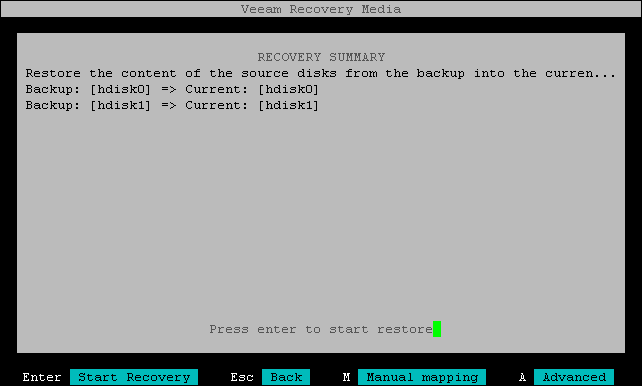Performing Flexible Mapping
Flexible mapping works at a more granular level of volume groups and logical volumes. It allows you to map specific volume groups and logical volumes from the backup (source) to the volume groups, logical volumes or disks on your machine (target). Flexible mapping allows for partial restore where you do not have to map all volume groups and logical volumes from the backup.
Considerations and Limitations
Before you begin flexible disk mapping, consider the following:
- You can manually map volume groups and logical volumes only in the Veeam Recovery Media wizard. Flexible disk mapping is not available when you perform bare metal recovery in the command line interface.
- The target volume group must be of the same size as the source volume group, or larger. You cannot map multiple volume groups to a target volume group; during restore, the source volume group will replace the target volume group on the current system.
- You can map a logical volume from the backup only to its original copy (with the same name and configuration) on the current system, or vice versa. You cannot map multiple logical volumes groups to a single logical volume.
- You can map a volume group to one or multiple disks on the current system. The combined size of the mapped disks must be the same or larger than the size of the source volume group.
- If you map objects from the backup to a disk on the current system, beware that during restore, the data form the backup will replace the content of the target disk on the current system.
- If you use flexible mapping, during bare metal recovery Veeam Agent will ignore the restore method settings.
When you perform flexible mapping during bare metal recovery, Veeam Agent behaves as follows:
- When you select flexible mapping, Veeam Agent compares information about the disks of the backed up machine and the disks on the current system. Depending on the result of this check, Veeam Agent works in one of the following ways:
- If the current machine on which you perform bare metal recovery contains disks with the same PVIDs as the PVIDs of the disks in the backup, Veeam Agent will try to import the volume groups from the disks with matching PVIDs. Veeam Agent will display information about the imported volume groups and logical volumes in the Current system pane of the Veeam Recovery wizard.
- If the current machine on which you perform bare metal recovery does not contain disks with the same PVIDs as the PVIDs of the disks in the backup, Veeam Agent will not import any volume groups and will simply display the amount of free space on the current system. This can happen, for example, if you perform bare metal recovery using a backup that was created on a different machine. You can press the [O] key to view how the free storage space is allocated among the disks on the current system. For more information on listing disks, see Listing Devices on Current System.
Important |
Before you initiate flexible mapping, make sure that none of the volume groups imported to the current machine are varied off. Otherwise, the recovery may fail due to name conflict. |
Tip |
You can manually import any volume groups to the current system before you launch flexible mapping. In this case, when you launch flexible mapping in the Recovery wizard, in the Current system pane, Veeam Agent will display the manually imported volume groups as well as the volume groups that were imported automatically based on matching PVIDs. |
- After you map objects from the backup to objects on the current system using the available mapping scenarios and press [R] and then [Enter] to start the recovery, Veeam Agent deletes on the current system the objects that have mappings. These can be volume groups, logical volumes and their content, as well as the content of the mapped devices (disks).
Important |
Thoroughly check your mapping before you start the restore. After you press [R] and then [Enter], Veeam Agent immediately proceeds to deleting data on the current system. If you choose to cancel the restore after it has been started, this may result in undesired data loss on the target system. |
- Once the deletion is completed on the current system, Veeam Agent replaces the deleted objects with the previously mapped objects from the backup. After the next system boot from hard drive, the current machine will contain the restored data.
Note |
After system reboot, you may need to manually import some or all non-system volume groups. For more information, see Finish Working with Veeam Recovery Media. |
You can use flexible mapping to map objects from the backup (source objects) to objects on the current system (target objects) in one of the following ways:
- Map a source volume group to a target volume group
- Map a source volume group to a target disk
- Map a source logical volume to a target logical volume
- Map a target volume group to a source volume group
- Map a target logical volume to a source logical volume
Note |
During bare metal recovery, you can combine different mapping scenarios. If you plan to do so, consider the following:
|
Launching Flexible Mapping
To launch flexible mapping, press the [F] key at the Recovery Summary step of the wizard.
